Vertiports Market
P
2025
Vertiports Market Size, Share, Competitive Landscape and Trend Analysis Report, by Type, by Solution, by Location : Global Opportunity Analysis and Industry Forecast, 2024-2033
Vertiports Market Research, 2033
The global vertiports market size was valued at $456 million in 2023, and is projected to reach $10.3 billion by 2033, growing at a CAGR of 36.3% from 2024 to 2033.
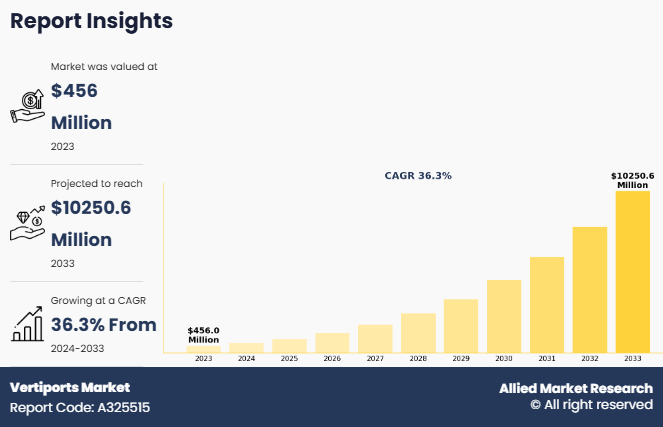
Report Key Highlighters
- The vertiports market studies more than 16 countries. The analysis includes a country-by-country breakdown analysis in terms of value available from 2022 to 2032.
- The research combined high-quality data, professional opinion and research, with significant independent opinion. The research methodology aims to provide a balanced view of the global market, and help stakeholders make educated decisions to achieve ambitious growth objectives.
- The research reviewed more than 3,700 product catalogs, annual reports, industry descriptions, and other comparable resources from leading industry players to gain a better understanding of the market.
- The vertiports market share is marginally fragmented, with players such as Volocopter GmbH, Bayards Vertiports, Aeroauto, Ferrovial, UrbanV, Groupe ADP, Skyportz, Skyway, Skyports Infrastructure Limited, Vports, Safeguard Engineering, Lilium Gmbh, Urban-Air Port Limited, eVertiSKY Crop and Varon Vehicles Corporation. Major strategies such as contracts, partnerships, expansion, and other strategies of players operating in the market are tracked and monitored.
Key Developments/Strategies in Vertiports
- In June 2023, Aeroauto signed an agreement with Volatus Infrastructure to deliver global vertiport and charging station solutions for Aeroauto's eVTOL sales and service centers.
- In February 2023, Bayards Vertiports entered into a cooperation agreement with SkyScape Japan (DroNext) and SafeHUB Systems to develop scalable vertiports in Japan. These vertiports will consist of modular blocks made from high-grade aluminum, enabling unique layouts and designs.
- In April 2024, Aeroauto partnered with CE+T America, a global leader in power solutions, to develop vertiports worldwide. Thrpugh this strategy, both companies transform mobile transportation by advancing the infrastructure for eVTOL operations.
- In October 2024, UrbanV signed an agreement with Korea Airports Corporation (KAC) to develop vertiport networks and create an AAM ecosystem. Furthermore, KAC is developing an in-house vertiport system and preparing vertiport infrastructure for the nation's first commercial AAM operations in Jeju Island and the Southern Coast Region.
Market Definition and Introduction
A vertiport is a special area made for vertical takeoff and landing (VTOL) aircraft. These include drones, air taxis, and other vehicles that hover and can be used in cities and suburbs. Vertiports are like heliports but designed to meet the specific needs of VTOL aircraft, which are expected to play a big role in the future of urban air travel.
Factors such as the rising demand for advanced air mobility (AAM) aircraft are turning vertiports into modern, efficient air transportation hubs. Automation and robotics play a key role, revolutionizing ground operations with greater efficiency. Automated systems enhance safety in ground movement, optimize resource allocation, and streamline passenger handling. By automating luggage handling, security checks, and check-ins, vertiports improve passenger flow and operational efficiency. However, high initial investment is restraining market growth. In June 2023, Groupe ADP signed a Memorandum of Understanding (MoU) with auto flight to conduct prosperity 1 eVTOL flight tests at pontoise airport during the 2024 Paris Olympic Games. With the addition of five new vertiports, Groupe ADP is at the forefront of developing eVTOL infrastructure in the Paris region.
The vertiports market growth heavily relies on the development of electric vertical takeoff and landing (eVTOL) aircraft, which form the foundation of urban air mobility (UAM) solutions. Advances in eVTOL technology are improving efficiency, safety, and practicality, making them a viable choice for urban transportation. Vertiport designs are adapting to meet the specific needs of eVTOL aircraft, including specialized landing pads, electric charging stations, maintenance facilities, and passenger terminals. These designs aim to blend vertiports into urban environments while reducing noise and visual disruption.
Safety and air traffic management are critical challenges for the vertiports industry, especially as urban air mobility (UAM) grows and more eVTOL (electric vertical takeoff and landing) aircraft enter urban airspace. Managing these aircraft in crowded city environments requires advanced systems to maintain safety and efficient airspace operations. Urban areas already face dense air traffic from commercial flights, general aviation, and emergency services. Adding eVTOL operations increases complexity, making advanced airspace integration strategies essential to avoid conflicts and ensure safe navigation. This trend is anticipated to fuel the growth of the vertiports market forecast.
Market Dynamics
Rise in need for technological advancements to develop vertiports
Technological advancements are at the forefront of driving growth in the vertiport market. As demand for advanced air mobility aircraft continues to increase, cutting-edge technologies are transforming vertiports into efficient and futuristic hubs for air transportation. A significant driver in this market is the integration of automation and robotics. These innovations have revolutionized ground operations, making them more streamlined and efficient. Automated systems facilitate seamless passenger management, resource allocation, and safety monitoring for ground movements. By automating processes such as check-in, baggage handling, and security checks, vertiports can greatly improve operational efficiency and optimize passenger flow. Robotics further enhance operations by handling precision-driven tasks such as luggage management and maintenance, reducing human error and enabling faster turnaround times for improved overall performance.
High initial investment
High initial investment is a major challenge for the vertiports industry. A significant portion of these costs develop from land acquisition, as suitable locations in urban or densely populated areas are often expensive. Identifying land that meets essential criteria, such as compliance with airspace regulations and proximity to transportation networks, adds complexity and further drives up expenses. In addition, the construction and infrastructure development of vertiports require substantial funding. These facilities must include specialized features such as landing pads, charging stations, maintenance hubs, and passenger amenities, all of which contribute to high construction costs. The incorporation of advanced technologies, including air traffic management systems and charging infrastructure, further amplifies the financial burden.
Efficient operation relies on the integration of advanced systems such as air traffic management, communication networks, radar systems, airspace management software, and charging solutions for eVTOL aircraft. Implementing these technologies requires significant investment and ensuring their seamless integration while adhering to regulatory standards adds further complexity and expense. Moreover, operational and maintenance costs represent ongoing financial commitments, which are additional challenges for the long-term sustainability of vertiports.
Increasing integration of vertiports with airports and train stations will create lucrative growth opportunities
The integration of vertiports with existing airports is a significant focus in the evolution of urban air mobility. For instance, NACO (Netherlands Airport Consultants) has partnered with Urban-Air Port (UAP) to facilitate the incorporation of vertiports into airports worldwide. This collaboration aims to determine how UAP's AirOne ground infrastructure technology can be seamlessly integrated into airport masterplans, enhancing connectivity between traditional air travel and emerging eVTOL services. In another example, Groupe ADP inaugurated Europe's first integrated vertiport at Pontoise. This facility brings together key technical components necessary for future electric aircraft operations, serving as a testing ground for urban air mobility solutions in the Paris region. Such factors will create lucrative growth opportunities in the vertiports market insights.
Segment Review
The vertiports market report is segmented into type, solution, location and region. By type, the market is divided into vertipads, vertihubs, and vertibases. On the basis of solution, the market is classified into landing pads, terminal gates, ground support equipment, charging stations, control stations, and others. By location, the market is divided into ground based, rooftop or elevated, and floating. Region-wise, the vertiports market trends are analyzed across North America (U.S., Canada, and Mexico), Europe (UK, Germany, France, and rest of Europe), Asia-Pacific (China, India, Japan, Australia, South Korea, and rest of Asia-Pacific), and LAMEA (Latin America, the Middle East, and Africa).
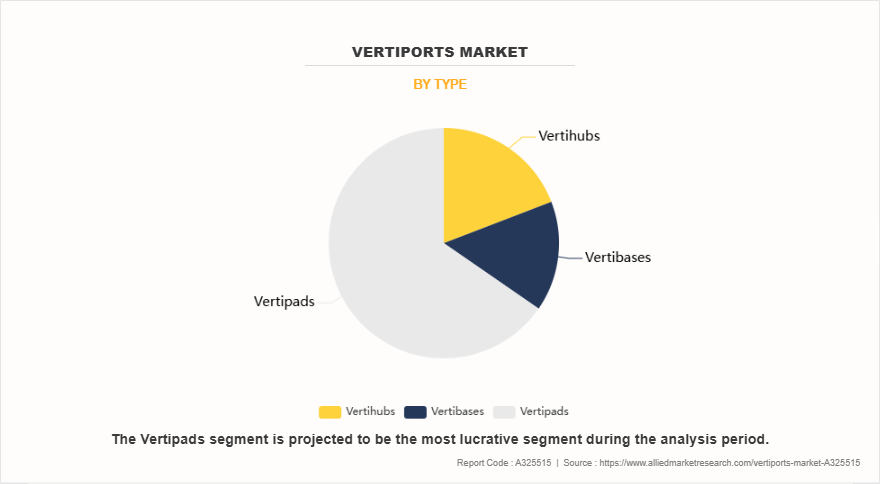
By Type
By type, the market is divided into vertipads, vertihubs, and vertibases. Vertipads segment accounted for the largest share in 2023. This segment is driven by the increasing demand for point-to-point urban air mobility solutions, the lower infrastructure costs associated with vertipads compared to vertihubs and vertibases, and the rising adoption of eVTOL aircraft for short-haul transportation. Additionally, government initiatives supporting advanced air mobility (AAM) infrastructure and the growing investments from private stakeholders further contribute to the expansion of this segment.
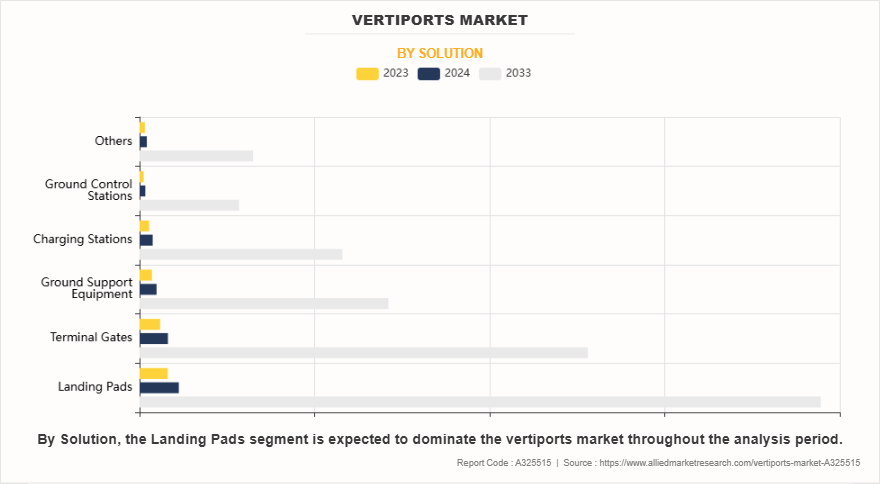
On the basis of solution, the market is classified into landing pads, terminal gates, ground support equipment, charging stations, control stations, and others. The landing pads segment holds a significant share, driven by the increasing deployment of vertiports to support urban air mobility (UAM) initiatives. The growing demand for safe and efficient takeoff and landing infrastructure for eVTOL aircraft is also a key factor proposing the segment‐™s growth. In addition, advancements in materials and smart technologies, such as automated lighting and weather monitoring systems, enhance the operational efficiency of landing pads.
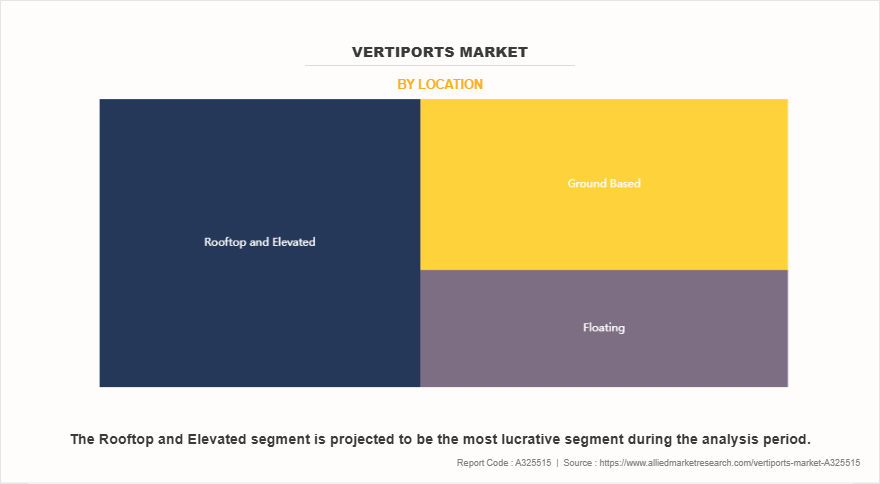
On the basis of location, the market is classified into ground based, rooftop or elevated, and floating. The rooftop and elevated segment holds a significant share, driven by driven by the increasing demand for optimizing urban spaces and minimizing land acquisition challenges. As urbanization accelerates, cities are focusing on utilizing existing infrastructure, such as rooftops of commercial buildings, parking structures, and transit hubs, to develop efficient solutions.
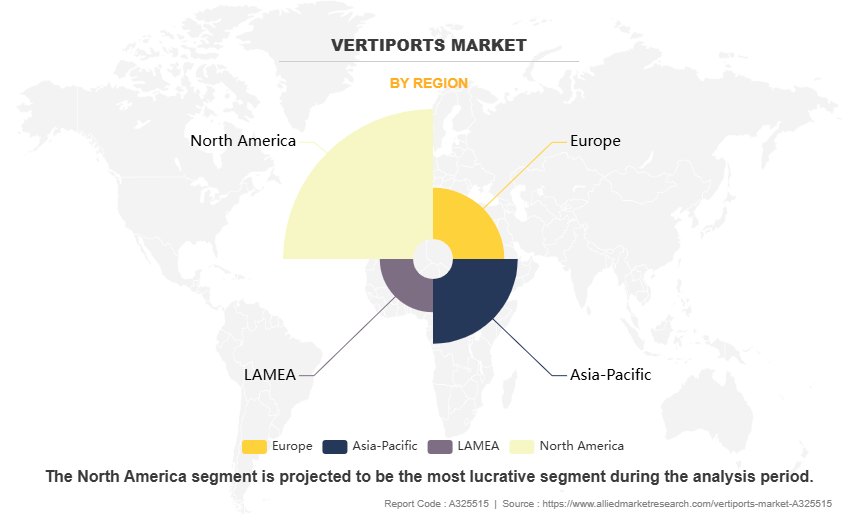
Region-wise, the vertiports market trends are analyzed across North America (U.S., Canada, and Mexico), Europe (UK, Germany, France, Russia, and rest of Europe), Asia-Pacific (China, India, Japan, Australia, South Korea, and rest of Asia-Pacific), and LAMEA (Latin America, the Middle East, and Africa). North America region dominated the market in 2023, driven by robust infrastructure development, significant government investments, and the presence of key industry players. The region's strong focus on technological advancements and innovation has led to the rapid adoption of cutting-edge solutions, enhancing efficiency and operational capabilities across various sectors. safety and fuel efficiency, has further fueled market growth.
Competitive Analysis
Competitive analysis and profiles of the major global vertiports market players that have been provided in the report include Volocopter GmbH, Bayards Vertiports, Aeroauto, Ferrovial, UrbanV, Groupe ADP, Skyportz, Skyway, Skyports Infrastructure Limited, Vports, Safeguard Engineering, Lilium Gmbh, Urban-Air Port Limited, eVertiSKY Crop and Varon Vehicles Corporation. The key strategies adopted by the major players of the global vertiports market are product launch and mergers & acquisitions.
Top Impacting Factors
The global vertiports market is expected to witness notable growth registering a CAGR of 36.3%, The vertiports market is expected to witness notable growth owing to rise in need for technological advancements to develop vertiports and increase in government investments. Increasing integration of vertiports with airports and train stations and rising traffic congestion and the need for smarter transportation are expected to provide lucrative opportunities for market growth. However, high initial investment and limited range and payload associated with vertiports may hamper market expansion.
Historical Data & Information
The global vertiports market is competitive, owing to the strong presence of existing vendors. Vendors in the global vertiports market with extensive technical and financial resources are expected to gain a competitive advantage over their competitors as they can cater to market demands, which are higher than the supply. The competitive environment in this market is expected to increase owing to technological innovations, product extensions, and different strategies adopted by key vendors.
Key Benefits For Stakeholders
- This report provides a quantitative analysis of the market segments, current trends, estimations, and dynamics of the vertiports market analysis from 2023 to 2033 to identify the prevailing vertiports market opportunities.
- The market research is offered along with information related to key drivers, restraints, and opportunities.
- Porter's five forces analysis highlights the potency of buyers and suppliers to enable stakeholders make profit-oriented business decisions and strengthen their supplier-buyer network.
- In-depth analysis of the vertiports market segmentation assists to determine the prevailing market opportunities.
- Major countries in each region are mapped according to their revenue contribution to the global market.
- Market player positioning facilitates benchmarking and provides a clear understanding of the present position of the market players.
- The report includes the analysis of the regional as well as global vertiports market trends, key players, market segments, application areas, and market growth strategies.
Vertiports Market Report Highlights
| Aspect | Details |
|---|---|
Market Size By 2033 | USD 10.3 billion |
Growth Rate | CAGR of 36.3% |
Forecast period | 2023 - 2033 |
Report Pages | 224 |
By Type |
|
By Solution |
|
By Location |
|
By Region |
|
Key Market Players | Varon Vehicles Corporation, LILIUM, Aeroauto, Groupe ADP, SKYPORTS INFRASTRUCTURE LIMITED, Safeguard Engineering, Volocopter GmbH, Ferrovial, eVertiSKY Crop., Vports, Skyway, Urban-Air Port Limited, UrbanV, Bayards Vertiports, Skyportz |
Related Tags
Vertiports MarketFrequently Asked Questions?
The global vertiports market was valued at $456 million in 2023.
The upcoming trends of vertiports market include rise in need for technological advancements to develop vertiports and increase in government investments.
The landing pads is the leading solution of vertiports market.
North America is the largest regional market for vertiports.
Volocopter GmbH, Bayards Vertiports, Aeroauto, Ferrovial, UrbanV are the top companies to hold the market share in Vertiports.

